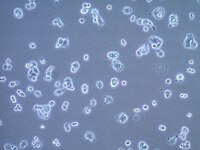SCC249 Sigma-AldrichHep-G2/2.2.15 Human Hepatoblastoma Cell Line
Recommended Products
개요
| Replacement Information |
|---|
| References |
|---|
| Product Information | |
|---|---|
| HS Code | 3002 59 00 |
| Biological Information | |
|---|---|
| Cell Line Type |
|
| Physicochemical Information |
|---|
| Dimensions |
|---|
| Materials Information |
|---|
| Toxicological Information |
|---|
| Safety Information according to GHS |
|---|
| Safety Information |
|---|
| Product Usage Statements | |
|---|---|
| Quality Assurance | • Each vial contains ≥ 1X10⁶ viable cells. • Cells tested positive for Hepatitis B virus (HBV) and negative for all other infectious diseases in the Human Essential CLEAR panel by Charles River Animal Diagnostic Services. • Cells are verified to be of human origin and negative for inter-species contamination from rat, mouse, chinese hamster, Golden Syrian hamster, and non-human primate (NHP) as assessed by a Contamination CLEAR panel by Charles River Animal Diagnostic Services. • Cells are negative for mycoplasma contamination. • Each lot of cells is genotyped by STR analysis to verify the unique identity of the cell line. |
| Usage Statement |
|
| Packaging Information | |
|---|---|
| Material Size | ≥1X10⁶ cells/vial |
| Transport Information |
|---|
| Supplemental Information |
|---|
| Specifications |
|---|
| Global Trade Item Number | |
|---|---|
| 카탈로그 번호 | GTIN |
| SCC249 | 04061841079842 |
Documentation
Data Sheet
| Title |
|---|
| Hep-G2/2.2.15 Human Hepatoblastoma Cell Line |










